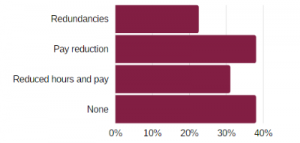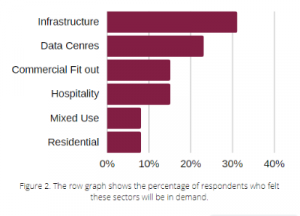Post Circuit Breaker : Impact on Circuit Breaker and the new Normal

As Singapore enters phase three, most businesses have resumed their operations in phases, progressively bringing staff back to the offices and sites. The built environment sector faces a number of unique challenges, many projects and construction activities stopped completely during the circuit breaker period and now must obtain approval from the government to restart activities and then maintain specific measures around testing and tracing for staff to remain active.
In this report, we have conducted a survey of over 2000 industry professionals working across built environment in Singapore to find out the changes they expect to happen as a result of Covid-19 pandemic.
Due to manpower disruption during the circuit breaker with the majority of projects experiencing delays and interruption, the construction sector is now expected to contract sharply by 10.3 percent this year in real terms, according to figures from Fitch Solutions.
According to our own survey of Singapore based built environment professionals (See figure 1), over 20 percent of respondents mentioned that their company has made redundancies during the Covid-19 period, while 38 percent of the respondents have been offered pay reductions and 31 percent have been offered both reduced hours and pay.

When asked how long they think the construction market will take to recover, 38 per cent of respondents cited that the construction market will take more than 1 year to recover. While 31 percent said they expect the market will take 9 – 12 months and the remaining respondents said it will take less than 9 months.
The resumption of activity for the construction sector will certainly take longer than expected because of the additional time taken to manage the spike in cases for the foreign workers and the challenges firm face in meeting and complying with government mandates for the safe restart.
Demand for workers
We expect to see a high demand for project staff as construction activities ramp up. This is down to two major factors, firstly and most obvious, the slowdown of construction activity and the project supply chain. The second factor which we have witnessed first hand at Archer is that with the challenge of mobilising a company into a full time WFH model almost overnight became the top priority many employers put recruitment either on hold or a long way down the priority list. This has meant a lack of pipelining is commonplace right now and most companies are now looking for the same candidate profile. An additional challenge to those looking to hire is around foreign labour and the ability to secure work passes.
In this tight labour market, respondents to our survey felt that the greatest demand after the circuit break will be in the following project types; infrastructure (31 percent), Data Centres (23 percent), commercial fit out (15 percent), hospitality (15 percent), mixed use (8 percent) and residential (8 percent). (Figure 2)

Hiring managers anticipate that experienced executives (2 – 5 year) will be most in demand in the months ahead, followed by mid-level management , graduatesand senior management. See figure 3 :

The specific roles which they anticipate will need to recruit are as follows: Business Development (46 percent), Project and Site Staff (38 percent) , Operations (23 percent), Design and BIM (15 percent) , Corporate Services (Legal, HR, S&M etc) (15 percent), and Tender and Commercial (8 percent).
Companies foresee many hiring challenges post circuit breaker. Thirty one percent of those surveyed feel that the biggest hiring challenge will be from the lack of internal company budget, followed by; skills shortage (23 percent), salary levels (23 percent), work pass restrictions (15 percent) and candidates unwilling to move due to job security (8 percent).
However, one significant change to our experience of the sector is that 77 percent of companies are open to consider hiring freelance candidates on short term requirements.
New Normal
People and organisations have learnt to live with the fact that Covid-19 will be around for the foreseeable future. As in most countries, one of the immediate changes organisations had to make in April this year was for their staff to work from home(WFH). This mandatory WFH period lasted until the first of June 2020, however some restrictions are still in place today.
According to our survey, even once further easing measures are announced, nearly half (46 percent) anticipate they will be working from home 2-3 days a week, while 23 percent anticipate 1 day a week, 23 percent will be working from home as much as required, with the remaining 14% working from home 4 days a week. (Shown in Figure 4)

Other significant changes that respondents believe will become the “new norm” include: 39 percent companies will move into a small office space in general due to increased WFH , while 31 percent will see a change in working hours to avoid peak travel times, 15 percent will rotate employees in the office on alternate day and a further 15 percent will see increase in interviews & meetings via video conference.
Companies must re-evaluate and make relevant changes to position their business to be resilient in facing Covid-19 or the next global threat. From a recruitment perspective, clients who have continued to pipeline proactively and manage their branding effectively to the active and passive job seeker will ultimately be the winners in the war for talent!
If you would like to discuss this survey in more detail or find out how Archer Recruitment can support your resourcing requirements during this challenging time, please contact David Cox at david@archerrecruitment.com or Samantha Soh at samantha@archerrecruitment.com.

© Archer Recruitment. All Rights Reserved.